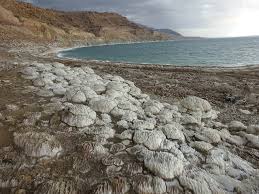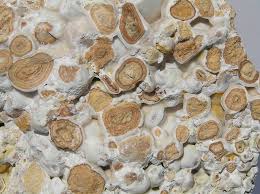Sediments are deposited from the surrounding environment through the activities of wind or water in various aquatic settings such as littoral zones, lacustrine environments, shallow water, lacustrine fans, and open water. Several depositional features form. In this article, the focus is on some of these depositional environments and features.
Littoral Depositional Environments
Lacustrine beaches and shallow littoral environments receive sediments from several sources. River-derived sediments can be redistributed along coastlines away from their original sources, especially in large lakes with strong secondary transport mechanisms.
On exposed coastlines under coastal currents, several geomorphic features can form, such as spits and barrier ridges. Local alluvial sources and coastal erosion processes provide sediment away from major river deltas, especially in lakes surrounded by large amounts of unconsolidated materials. Wind-derived sediment is also important in arid regions, where winds generate dune fields around lakes.
Read Also: 5 Amazing Health Benefits of Triphala (Three fruits)
Depositional Processes in Lacustrine Coastal Zones

Lacustrine beaches serve as areas of temporary sediment storage and are subject to frequent erosion. Their deposits are less informative for paleolimnological studies than deeper water zones or subsiding deltas. However, they are useful for recording episodic events like high lake stands, marking paleolake levels.
Within coastal sediment transport zones, wind-driven waves are the most significant agents for redistributing coarse sand and gravel. Even in the largest lakes, tides are minor features, creating only insignificant currents.
Longshore currents are weaker than those in coastal marine environments, and coastal pileup of water is rare. In lakes with steep offshore profiles, longshore transport is limited to small pocket beaches, beyond which sand is carried into deep water by gravity flows. In cases where coastal waves and longshore transport energies are strong enough to move sand, they create a mix of planar and ripple bedding.
Lacustrine fossils are rare or abraded in these deposits, while larger bed-forms such as mega ripples or large sand bars are common on exposed coastlines of large lakes.
In small lakes or protected embayments of larger ones, the “coastal belt” may be only meters wide, with muddy shorelines as typical features. These areas are described as thin-bedded, laminar to massive (bioturbated) silt and silty sand deposits, which are more likely to contain fossil invertebrates and aquatic macrophytes. Pond and embayment deposits are dominated by aquatic plant debris.
Classification of Unconsolidated, Organic-Rich Sediments of Shallow Lakes

Unconsolidated, organic-rich sediments of shallow lakes were originally classified based on their organic content. These include:
1. Gyttja (copropels): is a grey or dark brown sediment containing humic material, plant fragments, terrigenous sediment, diatom, and other algal and zooplankton remains. It has a textured appearance when wet, having been transformed into a mass of fecal pellets by chironomids or other benthos. Gyttjas form under oxygenated conditions.
2. Dy: is a type of gyttja formed under acidic or bog conditions, containing high concentrations of acidic humic materials. It appears brown and fibrous due to the abundance of peat particles.
3. Sapropels: are glossy black (when fresh, from reduced FeS) and generally finer-grained organic sediments. They contain abundant methane and hydrogen sulfide (CH4 and H2S) and other products of microbial reduction. Sapropels require reducing conditions to retain their appearance and composition, although this can develop seasonally from low-oxygen conditions or rapid accumulation of organic-rich sediment.
Shallow-Water Carbonate Depositional Environments in Lakes
Many lakes meet the conditions for the accumulation of calcium carbonate deposits, such as high rates of photosynthesis and relatively alkaline water. Lime muds and sands are common features of lake deposits. Marls are carbonate muds produced with low amounts of clastic material. When both siliciclastic and carbonate sediment sources are present in equal proportions, mixed carbonate/clastic deposits accumulate.
Read Also: The Effect of Solid Waste on Business Environments
Carbonate Sediments

Carbonate sediments behave differently from siliciclastic sediments during and after deposition. Carbonate minerals are relatively reactive under varying lake and diagenetic conditions, leading to mineral dissolution and replacement. These processes are particularly important in concentrated brines, near shorelines, and in areas of groundwater–sediment interaction.
The exposure of carbonate sediments through falling lake levels leads to characteristic diagenetic and soil-forming features, such as carbonate nodules, calcite-filled cracks, dissolution spaces (microkarst), and secondary cementation around roots. These features provide paleolimnological evidence of lake-level changes.
Some carbonate minerals form in lakes, such as low (0–5%) magnesium calcite, high magnesium calcite, and aragonite. Carbonate mineral assemblages provide information about lake water chemistry and temperature conditions during brine evolution at the time of precipitation. Brine evolution increases magnesium concentration during evaporation, favoring the formation of high magnesium calcite, aragonite, and dolomite.
Carbonate sediment is primarily produced within the photic zone, through the formation of various distinctive particles. The most common are:
- Lime muds formed mainly by direct calcite precipitation, and secondarily by the degradation of larger particles. Clay and silt-sized calcite or aragonite particles precipitate seasonally, often around bacteria or charophyte stems. Calcium carbonate muds are common in shallow water along low-energy lake margins, such as small lakes and ponds, or along protected coastlines in large lakes.
- Sand and gravel-sized carbonate particles are produced through several mechanisms. In lakes within limestone bedrock basins, eroded carbonate clasts can be transported into the lake. Bioclastic sediments, fragments from ostracode and mollusk shells or charophyte oogonia and stems, are a significant source of in-situ carbonate grains. Coated grains, including ooids and oncoids, also contribute to carbonate sediment accumulation.
Sublacustrine Fans
In deep lakes with steep margins, large deltas do not form because sediment is carried through gravity flows directly into deep water. This also occurs offshore from deltas with complex “stair-step” topography. Under these conditions, sediment may be transported as unconfined sheets of mud and sand, cascading downward as gravity flows.
Debris and grain flows result in chaotic deposits of sand, gravel, and boulders at the foot of steep slopes. Active scour from gravity flows or tectonic features can produce similar formations.
Sublacustrine fans resemble alluvial fans and some types of deltas in their lobate or radiating geometry. They grade into or are replaced by deltas over time as steep lake margins are transformed into gentler slopes through sediment infill.
When lithified, channel deposits preserve current indicators like ripple marks, tool marks, and flute casts, revealing the direction of paleo-flow. Levees surrounding the channels are generally composed of finer-grained, laminated, or massive muds. In distal settings, deepwater lacustrine turbidites become muddy, with occasional thin fine sands. Fossils are limited but may include shelly fossils introduced by gravity flows, such as ostracodes and mollusks.
Open Water (Pelagic and Hemipelagic) Deposition
In the central parts of a lake basin, sedimentation is dominated by the accumulation of materials settling from suspension. These include:
- Hemipelagic muds, transported offshore by surface or midwater currents, derived from river or shoreline erosion.
- Chemically precipitated sediments including carbonates, Fe & Mn oxides, hydroxides, and authigenic minerals.
- Wind-blown particles, including terrigenous dust, pollen, and volcanic tephra.
These deposits are characteristic of the central parts of large lakes or small lakes with limited river input. Organic debris from macrophytes or benthic algae can also be present in shallow lakes.
Pelagic sediments are primarily silt and clay-sized particles. Sand-sized particles are rare but can come from eolian sources, large turbidites, or fecal pellet aggregates. Far from river inputs, sediment accumulation rates are slow, offering high-resolution stratigraphic records from lake deposits.
Organic sediments can originate from both autochthonous and allochthonous sources. In large lakes, most organic matter is produced in the lake itself, including epilimnetic phytoplankton and bacteria growing at the chemocline. In small lakes, organic matter may represent a mix of local and external sources.
Alkaline lakes are particularly prone to the accumulation of laminated organic sediments due to rapid CO2 uptake and high biomass levels. After sedimentation, organic matter undergoes microbial decomposition, which can influence the formation of simpler organic and hydrocarbon compounds. Pyrite forms in sulfate-rich lakes under meromictic conditions or where organic accumulation rates are high.
Other sediment depositional environments include littoral zones, lacustrine coastal zones, and open water. Lacustrine deltas are significant entry points for sediments, and coastal environments are important zones for sediment reworking.
Carbonate deposits provide valuable information about biological activity and productivity, while pelagic sediments offer high-resolution records of lake conditions.
Do you have any questions, suggestions, or contributions? If so, please feel free to use the comment box below to share your thoughts. We also encourage you to kindly share this information with others who might benefit from it. Since we can’t reach everyone at once, we truly appreciate your help in spreading the word. Thank you so much for your support and for sharing!
Read Also: How Guava Fruits and Leaves Improve Female Fertility

